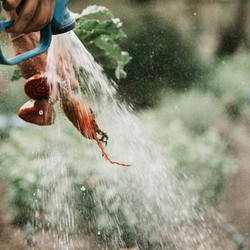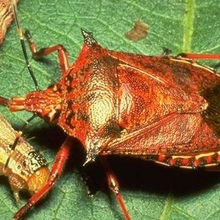(Editor's Note: This article was originally published on November 13, 2008. Your comments are welcome, but please be aware that authors of previously published articles may not be able to respond to your questions.)
When Americans sit down at the holiday dinner table, they are likely to see a dish called "candied yams". But this is a misnomer. While sweet potatoes and yams are both edible tubers, they otherwise have very little in common. Biologically, the two crops are entirely unrelated. Yams are an Old World crop, while sweet potatoes are native to the Americas.
The yam is a member of the family Dioscoreaceae, distantly related to lilies and grasses. There are hundreds of different yam cultivars, differing in size, color, texture and taste, but the most important varieties are grown in tropical West Africa, where the yam has always been a staple food crop. Its importance can be seen in the fact that the name derives from the word "to eat" in several West African languages: nyam or nyama.
The African yam requires a very long growing season, usually at least 250 days, which makes it unsuitable for a temperate climate. Most varieties can only be grown in the warmest zones of the U.S. Yams are large, vining plants, and the tubers, usually yellow or white, can weigh over a hundred pounds. Both the cultivation and preparation are labor-intensive. As most varieties are toxic when raw, the typical preparation involves hours of pounding in a mortar, resulting in a bland, starchy paste.

As opposed to yams, all real potatoes have their origin in the Americas. Columbus encountered the sweet potato being cultivated in the Caribbean, while the white potato, a cool climate crop, originated in the Andes. The sweet potato, Ipomoea batatas, is only distantly related to the white potato, Solanum tuberosa (a member of the nightshade family, which also includes tomatoes.) "Batatas" was the Arawak word for the sweet potato, from which the word "potato" is derived. "Potato" originally referred to the sweet potato, which was more widely grown in the USA than the white potato until it was re-introduced from Ireland in the 19th century. Since WWII, the production of sweet potatoes in this country has declined to about one-third of its former level.

Sweet potatoes belong to the morning glory family, and gardeners should be able to see the resemblance in the shape of the leaves and flowers, although sweet potato plants do not always flower. However, some varieties of sweet potato are grown as ornamentals.

Sweet potatoes are vining plants which, like African yams, are usually sprouted from root or vine cuttings, rather than from seed. Sweet potato plants are tender annuals and also require a long growing season, at least 120 days, so that traditionally this crop is grown in the southern United States, although earlier-maturing varieties have now been developed. It is relatively easy to grow, although susceptible to drought and some pests.
 |
|
|
Most of the sweet potatoes originally grown in the U.S. were not the deep orange-fleshed varieties more common today. Those earlier potatoes were firmer, more mealy and less sweet, often with white flesh – more like today's baking potato. The "white sweet potatoes" are no longer grown commercially in large quantities, although several varieties are available to the gardener. The word "yam" was first used to distinguish the sweeeter, orange-fleshed varieties from the more common white sweet potatoes. It is supposed that this word was introduced by slaves, who thought that the tubers resembled the African yams with which they were familiar. While the USDA allows the orange variety to be labeled as "yams," it requires that "sweet potato" also be used, for the sake of accuracy. Confusion between the two terms still exists, however.
Sweet potatoes are particularly compatible with traditional holiday foods such as turkey and ham, and most commercial crops are now grown for this market. Sweet potatoes are usually held in storage to "cure" before being sold. Unfortunately, all too often, they appear on the table in the form of a casserole made from canned "candied yams," topped with marshmallows.
The sweet potato deserves better. You deserve better. Here are a couple of festive holiday recipes suggesting different ways to cook and serve this nutritious vegetable, using the real thing.
Orange Twice-Baked Sweet Potatoes
Bake 6 medium-sized sweet potatoes in a 375 F degree oven for at least an hour, or until they are soft. The baking caramelizes the sugar in the potatoes and intensifies the flavor. Scoop out the flesh into a mixing bowl and add ¼ cup each of butter and orange juice, and the grated zest of ½ an orange. Beat until smoothly pureed, then turn into a buttered casserole. Return to the oven for another 20 - 30 minutes, or until the top begins to brown. Avoid the temptation to add marshmallows, sprinkle with sugared pecans, instead.
Honey Sweet Potatoes
Boil 4 large sweet potatoes until they are just cooked through, then let them cool. [This can be done the night before the feast.] Peel and slice the cooled potatoes, then cut into slices ½ thick. Melt ½ cup butter in a large pan, add the slices and sauté over low heat until they are lightly browned, turning the slices. Pour 6 ounces of honey over the slices in the pan, sprinkle with ¼ teaspoon nutmeg, and continue to cook the sweet potatoes in the honey for another ten minutes. It wouldn't hurt to add 1 tablespoon dark rum with the honey. For that matter, the sugared pecans wouldn't hurt, either.
Photo Credits: PlantFiles
http://commons.wikimedia.org/wiki/Commons:GNU_Free_Documentation_License
















